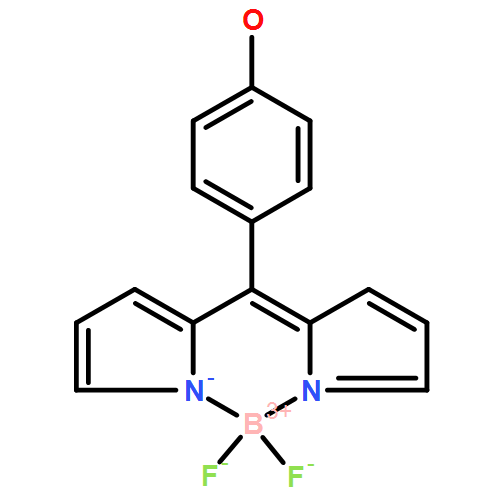Co-reporter: Changho Sohn, Jisu Jeong, Ji Hye Lee, Byung Hoon Choi, Hyonseok Hwang, Gyun-Tack Bae, Kang Mun Lee and Myung Hwan Park
pp: 5825-5832
Publication Date(Web):03 Mar 2016
DOI: 10.1039/C5DT05067G
Three novel BODIPY-based heterodinuclear complexes, [salen(3,5-tBu)2Al-(OC6H4-BODIPY)] (6), [salen(3,5-tBu)2Al-(OC6F2H2-BODIPY)] (7), and [(mq)2Al-(OC6H4-BODIPY)] (8) (salen = N,N′-bis(salicylidene)ethylenediamine, BODIPY = 4,4-difluoro-4-bora-3a,4a-diaza-s-indacene, and mq = methyl-8-quinolinolato) were prepared and characterized by multinuclear NMR spectroscopy. The specific structures of 6–8 were also determined by single crystal X-ray analysis. In particular, the salen-based heterodinuclear complexes 6 and 7 exhibited higher thermal stability (Td5 = 309 and 306 °C, respectively) than that of the closely related mononuclear aluminum or BODIPY compounds, except for 8. The UV/vis absorption and PL spectra for 6 and 7 indicated a significant photoinduced energy transfer from the aluminum–salen moiety to the BODIPY group in an intramolecular manner. Theoretical calculations revealed independent transition states of the aluminum–salen moiety or the BODIPY group in the AlIII–BODIPY dyads, further supporting these experimental results.
Co-reporter: Changho Sohn, Jisu Jeong, Ji Hye Lee, Byung Hoon Choi, Hyonseok Hwang, Gyun-Tack Bae, Kang Mun Lee and Myung Hwan Park
pp: NaN5832-5832
Publication Date(Web):2016/03/03
DOI: 10.1039/C5DT05067G
Three novel BODIPY-based heterodinuclear complexes, [salen(3,5-tBu)2Al-(OC6H4-BODIPY)] (6), [salen(3,5-tBu)2Al-(OC6F2H2-BODIPY)] (7), and [(mq)2Al-(OC6H4-BODIPY)] (8) (salen = N,N′-bis(salicylidene)ethylenediamine, BODIPY = 4,4-difluoro-4-bora-3a,4a-diaza-s-indacene, and mq = methyl-8-quinolinolato) were prepared and characterized by multinuclear NMR spectroscopy. The specific structures of 6–8 were also determined by single crystal X-ray analysis. In particular, the salen-based heterodinuclear complexes 6 and 7 exhibited higher thermal stability (Td5 = 309 and 306 °C, respectively) than that of the closely related mononuclear aluminum or BODIPY compounds, except for 8. The UV/vis absorption and PL spectra for 6 and 7 indicated a significant photoinduced energy transfer from the aluminum–salen moiety to the BODIPY group in an intramolecular manner. Theoretical calculations revealed independent transition states of the aluminum–salen moiety or the BODIPY group in the AlIII–BODIPY dyads, further supporting these experimental results.
